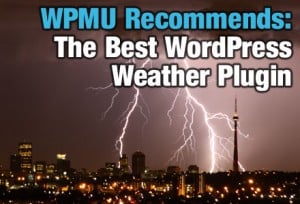WPMU Recommends: Best WordPress Weather Widget
 When you search the WordPress Plugin Directory for a weather widget plugin, you’ll be overwhelmed by the results. Start installing them, though, and you’ll see many are garbage, some are almost perfect–but you may not find one that does everything you need.
When you search the WordPress Plugin Directory for a weather widget plugin, you’ll be overwhelmed by the results. Start installing them, though, and you’ll see many are garbage, some are almost perfect–but you may not find one that does everything you need.
I have good news: WPMU found a weather widget for you.
The Best Weather Widget: wp-forecast

Let me get straight to the point: install the wp-forecast weather plugin, and you’ll never have to decide which weather features to compromise on again.
I avoided looking at plugin directory stats until after making my decision. I picked the most promising 7 plugins, and went from there. When I picked wp-forecast, I wasn’t too surprised to see it has:
- Matured to version 4.0
- Been downloaded almost 89,000 times.
- Existed in active development since 2007.
Why should you use wp-forecast?
The question really is, why shouldn’t you? Seriously, that is how I approached this comparison. I made a list of 7 criteria, and the plugins with the most “fails” in those criteria fell by the wayside. My criteria:
1. Bug free.
I looked for noticeable errors, as well as errors thrown into my debug log. The only issue wp-forecast had was to throw a few PHP Notices for undefined indexes. While I personally try to code so these notices don’t occur, they are about as common as mosquitos–and they hurt much less (not at all.)
2. Display flexibility
Quite simply, where can the plugin display weather information? With wp-forecast, you can configure multiple widgets, each with their own settings like city and display preferences. You can also easily display weather data in a template file or in page content using a shortcode.
3. Display aesthetics
How nicely is weather information displayed? While other plugins made it easier to change icon sets, wp-forecast looks good right out of the box. With a little time, you can easily get more icon sets and change styling via CSS. It really was easy–I just followed the directions.
4. Easy to configure

At first, the wp-forecast setting screen looks a bit intimidating. That’s just because there are so many options. If you can spare more than 60 seconds to actually read what options are there, you can get wp-forecast up and running for whatever cities you need.
FREE EBOOK
Your step-by-step roadmap to a profitable web dev business. From landing more clients to scaling like crazy.
FREE EBOOK
Plan, build, and launch your next WP site without a hitch. Our checklist makes the process easy and repeatable.
5. Weather data options
What pieces of weather data do you want to display? wp-forecast can show you just about everything you could possibly want–especially if you configure it to pull data from Accuweather. You can even configure certain data to show the current conditions, daily forecast, nightly forecast, or all three.
6. Well-coded
This involved me getting under the hood, looking at some code. I didn’t spend a lot of time, but wp-forecast was definitely one of the best-built packages. That’s really saying something, since the plugin folder is full of subdirectories and files all over the place! There’s a lot to keep track of in there, and it still seems held together well after more than 5 years in development.
Something to complain about
One minor negative cropped up for me here, as it did for most of the plugins that had a settings screen. wp-forecast chose to create a new menu link in the sidebar (at the same level as “Pages,” “Appearance,” “Plugins,” etc.) In my professional opinion, there is no reason not to put wp-forecast settings as a subitem under “Settings.”
Like I said–I had to complain about something–and this is nearly all I could find!
7. Weather data sources
I personally like to use the Wunderground site for my weather. wp-forecast doesn’t support Wunderground as a source. It does support AccuWeather, WeatherBug, and GoogleWeather. I have to admit–AccuWeather is pretty good. There were some good contenders supporting Weather Underground and OpenWeather.com, but those plugins couldn’t cut the mustard in other, more important areas.
Where do we go from here?
If you want an easy, attractive way to display current weather conditions and forecast, wp-forecast is the choice you should make. If you like to tinker in WordPress and want more “control” over your weather, wp-forecast still delights, with its own API available for your Frankenstein-inspired coding experiments.
Unless you’re wedded to some weather information provider wp-forecast doesn’t support, there’s really no reason to install any other weather plugin. Just get it done!
Credits
- Lightning over Johannesburg photo: Derek Keats

